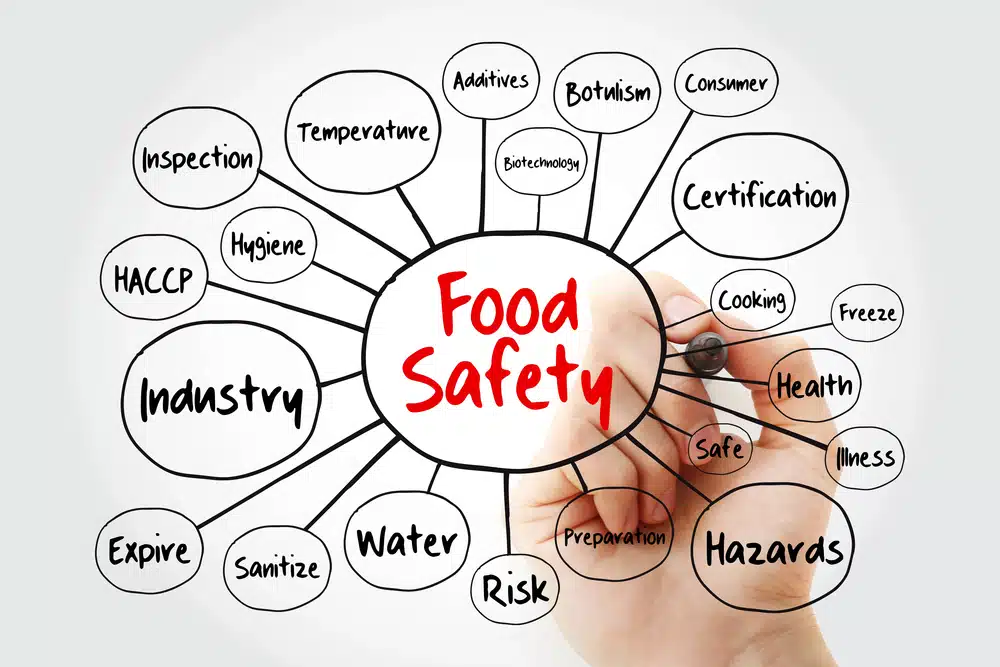Article At A Glance
- Avoid Costly Mistakes: Learn how to identify and resolve common food safety problems.
- Minimize Contamination Risks: Implement practices to prevent cross-contamination and unsafe handling.
- Ensure Compliance: Stay ahead of food safety standards to protect your customers and operations.
- Get Expert Help: Discover how B&B Food Services supports food establishments in staying safe and compliant.
Food safety is vital to running a successful food business. Overlooking key safety measures can lead to contamination, foodborne illnesses, and even legal repercussions. Beyond the financial costs, these lapses can severely damage your reputation. Identifying and preventing food safety problems is essential to protecting your business.
While running a busy food operation, it’s easy to overlook small details that can lead to significant problems. However, even a single misstep, such as an incorrectly stored ingredient or a poorly cleaned utensil, can trigger a cascade of safety issues. Below, we’ll explore ten critical food safety red flags and how to address them before they become liabilities.
Improper Cooling of Cooked Foods
Cooling cooked foods too slowly is one of the most significant culprits of foodborne illnesses. Foods left in the temperature “danger zone” (40°F to 140°F) for extended periods can become contaminated with bacteria like Salmonella or E. coli. Unfortunately, busy kitchens often overlook proper cooling practices, resulting in costly and sometimes hazardous consequences.
Tips to Prevent Improper Cooling:
- Use Shallow Containers: Immediately transfer hot foods into shallow pans to accelerate cooling.
- Divide Large Batches: Separate large quantities into smaller portions to cool faster and more evenly.
- Utilize Blast Chillers: Invest in tools like blast chillers or ice baths for rapid cooling.
For example, cooling a large soup pot can be expedited by dividing it into multiple shallow containers and placing them in a cold water bath. Adding an ice wand or circulating the containers within a refrigerated prep table can further reduce the time food spends in the danger zone. Proper cooling techniques not only safeguard customer health but also ensure compliance with food safety guidelines.
Inadequate Handwashing Practices
Handwashing is a simple yet critical aspect of food safety, as improper hygiene can spread harmful microorganisms to food. Studies show that 89% of foodborne illness outbreaks are linked to insufficient handwashing practices in food establishments.
Actionable Solutions:
- Mandatory Training: Educate all staff on handwashing techniques, emphasizing the use of soap and warm water for at least 20 seconds.
- Accessible Handwashing Stations: Install conveniently placed sinks equipped with soap, paper towels, and touch-free faucets.
- Visual Reminders: Post clear signage reminding team members to wash their hands after handling raw food, using the restroom, and other activities.
Beyond reminders, having supervisors regularly observe and coach staff on hygiene practices ensures accountability. Regular audits to ensure compliance can significantly reduce the risk of contamination.
Improper Food Storage Temperatures
Incorrect food storage is one of the most commonly reported food safety problems. Perishable foods stored at improper temperatures can spoil quickly, increasing the risk of serving contaminated products to customers.
Key Steps to Maintain Safe Storage:
- Refrigeration Best Practices: Store perishable items at 40°F or below and frozen goods at 0°F or below.
- Temperature Monitoring Systems: Utilize digital thermometers and automated alerts to detect deviations in real-time.
- Label and Rotate: Implement a “first in, first out” (FIFO) system to ensure older items are used before new stock.
Organizing walk-in coolers with labeled shelves and color-coded bins can streamline checks and reduce oversight. For example, storing meat on the lowest shelf prevents raw juices from contaminating other foods. These practices keep inventory fresh and foodborne illnesses at bay.
Contaminated Food Contact Surfaces and Utensils
Poorly sanitized surfaces and utensils are prime sources of cross-contamination in kitchens. Bacteria from raw ingredients can easily transfer to ready-to-eat foods if thorough cleaning protocols aren’t followed.
Solutions for Safer Surfaces:
- Color-Coded Utensils: Assign specific cutting boards and knives for raw meats, produce, and dairy.
- Routine Cleaning: Sanitize surfaces and tools after each use with food-safe disinfectants.
- Regular Inspections: Conduct routine evaluations of cleanliness to ensure compliance.
Food prep stations should be sanitized before, during, and after peak hours. Even a simple practice like wiping down countertops frequently can eliminate bacterial growth and improve overall operations. It’s also helpful to log when and how each area is cleaned to ensure tasks aren’t missed.
Improper Labeling of Prepared Foods
Labeling mishaps can lead to serving expired, mislabeled, or allergen-contaminated food. This not only poses health risks but can also drive customers away.
Steps to Improve Labeling:
- Include Essential Information: Clearly label all food items with preparation dates, expiration dates, and allergen details.
- Use Digital Systems: Leverage label-printing tools to avoid handwriting errors.
- Appoint a Labeling Lead: Assign responsibility to a specific team member for label accuracy.
Labels should be easy to read and consistent throughout the kitchen. Proper labeling also communicates professionalism and transparency during inspections. It builds trust with customers and demonstrates a commitment to safety.
Bare-Hand Contact with Ready-to-Eat Foods
Direct contact between human hands and foods like salads or sandwiches is a major violation of food safety standards. Even with clean hands, gloves provide an extra barrier that minimizes contamination risks.
Best Practices:
- Mandatory Glove Use: Provide gloves for all staff handling ready-to-eat foods.
- Offer Additional Tools: Use tongs and serving utensils as alternatives to gloves.
- Monitor Glove Hygiene: Train employees to change gloves frequently, especially after touching non-food items or raw ingredients.
Staff should also be taught not to treat gloves as a permanent solution. Gloves must be changed regularly, and handwashing should still be performed between tasks. Encouraging no-contact handling ensures customers receive food prepared in the safest, most hygienic way possible.
Cross-Contamination Between Raw and Ready-to-Eat Foods
Raw meats and seafood are teeming with harmful pathogens, which can contaminate ready-to-eat products if not handled correctly. Failure to control cross-contamination is a leading factor in food safety citations.
Prevention Techniques:
- Separate Work Areas: Designate specific stations for handling raw foods away from cooked or fresh items.
- Use Distinct Tools: Invest in different tools for raw versus cooked products (e.g., red cutting boards for raw meats).
- Employee Training: Train staff to understand the dangers of cross-contamination and how to prevent it.
Signage near prep stations, regular oversight, and role-specific training can reinforce these habits. By following these methods, your operation can avoid major food safety citations and keep customers safe.
Improper Hot Holding Practices
Many food businesses rely on hot holding equipment like steam tables or heat lamps to maintain food temperature during service. However, failing to maintain the right temperature increases the risk of bacterial growth.
Tips for Proper Hot Holding:
- Monitor Temperatures Frequently: Use food-safe thermometers to check holding temperatures regularly.
- Stir Often: Keep food evenly heated by stirring periodically.
- Set Safe Baselines: Maintain hot foods at or above 140°F to prevent them from entering the danger zone.
Creating a log sheet to record temperatures every 30 minutes can help track trends and identify failing equipment before it becomes a risk. Providing staff with hands-on training for using hot holding equipment correctly significantly reduces safety risks.
Inadequate Reheating of Foods
Improper reheating leaves pathogenic bacteria alive and can result in severe health consequences for consumers. Safe reheating requires food to reach an internal temperature of 165°F for at least 15 seconds.
Guidance for Better Reheating:
- Standardize Processes: Provide clear temperature requirements for each type of food item.
- Use Calibrated Thermometers: Check food temperatures consistently to ensure compliance.
- Avoid Microwave Quick Heats: Instead, use ovens or stovetops for more even reheating.
Every reheating method should include visual checks and temperature verification. These procedures ensure customer safety and meet food safety and inspection service standards.
Pest Infestations
Pests like rodents, cockroaches, and flies can compromise food safety and tarnish your brand reputation. Infested areas often spread bacteria, contaminate food supplies, and create unsanitary conditions.
Steps to Prevent Infestations:
- Routine Pest Control: Partner with licensed pest management services to conduct regular inspections.
- Seal Entry Points: Check for gaps around doors, windows, and pipes where pests could enter.
- Keep Areas Clean: Avoid leaving food exposed, empty trash frequently, and fix leaks promptly.
Maintaining a cleaning schedule that includes often-neglected areas, like under appliances and behind shelves, can make a huge difference. These preventative measures can save your business from costly closures or fines.
Protect Your Business & Reputation with B&B Food Services
Addressing food safety red flags proactively is crucial to protecting not only your customers but also your bottom line. Neglecting these elements could result in financial losses, legal consequences, and a diminished reputation.
At B&B Food Services Inc., we understand the challenges of maintaining compliance with food safety regulations. Our tailored solutions, expert training programs, and hygiene audits equip your business to meet the highest safety standards.
Whether you need help with temperature monitoring, pest control, or staff education, B&B Food Services is your trusted partner in achieving food safety excellence. We take the time to assess your unique needs and deliver actionable insights that drive real results.
Call us today at (815) 834-2621 to learn how we can help protect your operation and ensure customer satisfaction!

